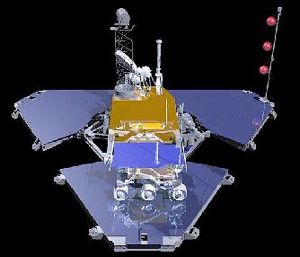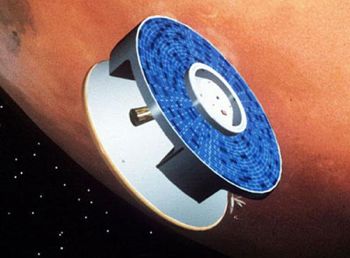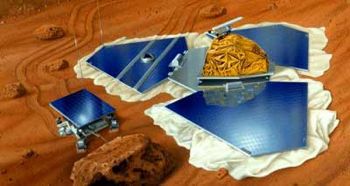
Home - Search - Browse - Alphabetic Index: 0- 1- 2- 3- 4- 5- 6- 7- 8- 9
A- B- C- D- E- F- G- H- I- J- K- L- M- N- O- P- Q- R- S- T- U- V- W- X- Y- Z
Mars Pathfinder
 Mars Sojourner Credit: NASA |
AKA: MFEX;MPF Cruise Stage;Sojourner. Status: Operational 1996. First Launch: 1996-12-04. Last Launch: 1996-12-04. Number: 3 .
NASA NSSDC Master Catalog Description
The Mars Pathfinder was the second of NASA's low-cost planetary Discovery missions to be launched. The mission consists of a stationary lander and a surface rover. The mission had the primary objective of demonstrating the feasibility of low-cost landings on and exploration of the Martian surface. This objective was met by tests of communications between the rover and lander, and the lander and Earth, tests of the imaging devices and sensors, and tests of the maneuverability and systems of the rover on the surface. The scientific objectives include atmospheric entry science, long-range and close-up surface imaging, rock and soil composition and material properties experiments, and meteorology, with the general objective being to characterize the Martian environment for further exploration. (Mars Pathfinder was formerly known as the Mars Environmental Survey (MESUR) Pathfinder.)
Mars Pathfinder was launched on a Delta 7925 (a Delta II Lite launch vehicle with nine strap-on solid-rocket boosters and a Star 48 (PAM-D) third stage) at 6:58:00 UT (1:58 a.m. EST) on 4 December 1996. The spacecraft entered the Martian atmosphere on 4 July 1997 directly from its approach hyperbola at about 7300 m/s without going into orbit around the planet. The cruise stage was jettisoned 30 minutes before atmospheric entry. The lander took atmospheric measurements as it descended. The entry vehicle's heat shield slowed the craft to 400 m/s in about 160 seconds. A 12.5 meter parachute was deployed at this time, slowing the craft to about 70 m/s. The heat shield was released 20 seconds after parachute deployment, and the bridle, a 20 meter long braided Kevlar tether, deployed below the spacecraft. The lander separated from the backshell and slid down to the bottom of the bridle over about 25 seconds. At an altitude of about 1.6 km, the radar altimeter acquired the ground, and about 10 seconds before landing four air bags inflated in about 0.3 seconds forming a 5.2 meter diameter protective 'ball' around the lander. Four seconds later at an altitude of 98 m the three solid rockets, mounted in the backshell, fired to slow the descent, and about 2 seconds later the bridle was cut 21.5 m above the ground, releasing the airbag-encased lander. The lander dropped to the ground in 3.8 seconds and impacted at 16:56:55 UT (12:56:55 p.m. EDT) on 4 July 1997 at a velocity of 18 m/s - approximately 14 m/s vertical and 12 m/s horizontal - and bounced about 12 meters (40 feet) into the air, bouncing at least another 15 times and rolling before coming to rest approximately 2.5 minutes after impact and about 1 km from the initial impact site.
After landing, the airbags deflated and were retracted. Pathfinder opened its three metallic triangular solar panels (petals) 87 minutes after landing. The lander first transmitted the engineering and atmospheric science data collected during entry and landing, the first signal being received at Earth at 18:34 UT (2:34 p.m. EDT). The imaging system obtained views of the rover and immediate surroundings and a panoramic view of the landing area and transmitted it to Earth at 23:30 UT. After some maneuvers to clear an airbag out of the way, ramps were deployed and the rover, stowed against one of the petals, rolled onto the surface on 6 July at about 05:40 UT (1:40 a.m. EDT).
The bulk of the lander's task was to support the rover by imaging rover operations and relaying data from the rover to Earth. The lander was also equipped with a meteorology station. Over 2.5 meters of solar cells on the lander petals, in combination with rechargeable batteries, powered the lander. The lander on-board computer is based on 32-bit architecture with 4 million bytes of static random access memory and 64 million bytes of mass memory for storing images. The main lander components are held in a tetrahedral shaped unit in the center of the three petals, with three low-gain antennas extending from three corners of the box and a camera extending up from the center on a 0.8 meter high pop-up mast. Images were taken and experiments performed by the lander and rover until 27 September 1997 when communications were lost for unknown reasons.
The landing site in the Ares Vallis region of Mars is at 19.33 N, 33.55 W. The lander has been named the Sagan Memorial Station. The Ares Vallis region of Mars is a large outwash plain near Chryse Planitia. This region is one of the largest outflow channels on Mars, the result of a huge flood (possibly an amount of water equivalent to the volume of all five Great Lakes) over a short period of time flowing into the martian northern lowlands.
The Mars Pathfinder mission cost approximately $265 million including launch and operations. Development and construction of the lander cost $150 million and the rover about $25 million.
NASA NSSDC Master Catalog Description
The Mars Pathfinder was the second of NASA's low-cost planetary Discovery missions to be launched. The mission consists of a stationary lander and a surface rover. The mission had the primary objective of demonstrating the feasibility of low-cost landings on and exploration of the Martian surface. This objective was met by tests of communications between the rover and lander, and the lander and Earth, tests of the imaging devices and sensors, and tests of the maneuverability and systems of the rover on the surface. The scientific objectives include atmospheric entry science, long-range and close-up surface imaging, rock and soil composition and material properties experiments, and meteorology, with the general objective being to characterize the Martian environment for further exploration. (Mars Pathfinder was formerly known as the Mars Environmental Survey (MESUR) Pathfinder.)
The rover, which has been named "Sojourner" is a six-wheeled vehicle, 280 mm high, 630 mm long, and 480 mm wide with a ground clearance of 130 mm, mounted on a "rocker-bogie" suspension. The rover was stowed on the lander at a height of 180 mm. At deployment, the rover extended to its full height and rolled down a deployment ramp at about 05:40 UT on 6 July 1997 (1:40 a.m. EDT). The rover was controlled by an Earth-based operator who used images obtained by both the rover and lander systems. Note that the time delay was between 10 and 15 minutes depending on the relative position of Earth and Mars over the course of the mission, requiring some autonomous control, provided by a hazard avoidance system on the rover. The on-board control system is an Intel 80C85 8-bit processor which runs about 100,000 instructions per second. The computer is capable of compressing and storing a single image on-board. The rover is powered by 0.2 square meters of solar cells, which will provide energy for several hours of operations per sol (1 Martian day = 24.6 Earth hours). Non-rechargeable lithium thionyl chloride (LiSOCl2) D-cell batteries provide backup. All rover communications were done through the lander.
The rover is equipped with black and white and color imaging systems which were used to image the lander in order to assess its condition after touchdown. The goal was to acquire three black and white images spaced 120 degrees apart of the lander. Images of the surrounding terrain were also acquired to study size and distribution of soils and rocks, as well as locations of larger features. Imaging of the rover wheel tracks will be used to estimate soil properties. Imaging of the rover by the lander was also done to assess rover performance and soil and site properties. The rover's performance was monitored to determine tracking capabilities, drive performance, thermal behavior, and sensor performance. UHF Communications between the rover and lander were studied to determine the effectiveness of the link between the rover and lander. Assessments of rock and soil mechanics will be made based on abrasion of the wheels and adherence of dust. An alpha-proton-X-ray spectrometer (APXS) is on-board the rover to assess the composition of rocks and soil. Images of all samples tested are transmitted to Earth. The primary objectives were scheduled for the first seven sols, all within about 10 meters of the lander. The extended mission included slightly longer trips away from the lander, and even longer journeys were planned. Images were taken and experiments performed by the lander and rover until 27 September 1997 when communications were lost for unknown reasons.
The landing site in the Ares Vallis region of Mars is at 19.33 N, 33.55 W. The lander has been named the Sagan Memorial Station. The Ares Vallis region of Mars is a large outwash plain near Chryse Planitia. This region is one of the largest outflow channels on Mars, the result of a huge flood (possibly an amount of water equivalent to the volume of all five Great Lakes) over a short period of time flowing into the martian northern lowlands.
The Mars Pathfinder mission cost approximately $265 million including launch and operations. Development and construction of the lander cost $150 million and the rover about $25 million.
More at: Mars Pathfinder.
Family: Mars rover. Country: USA. Engines: Star 5. Launch Vehicles: Thor, Delta, Mars tactical rocket, Delta 2 7000, Delta 7925. Projects: Discovery series, Mars. Launch Sites: Cape Canaveral, Cape Canaveral LC17B. Agency: JPL, NASA. Bibliography: 2, 279, 3946, 3947, 3948, 4, 6687, 12809.
 | Opportunity (Mars Ex Credit: Manufacturer Image |
 | Mars Pathfinder Credit: Manufacturer Image |
1996 December 4 - . 06:58 GMT - . Launch Site: Cape Canaveral. Launch Complex: Cape Canaveral LC17B. LV Family: Thor. Launch Vehicle: Delta 7925.
- Mars Pathfinder - . Payload: Discovery 2. Nation: USA. Agency: JPL, NASA. Program: Discovery series. Class: Mars. Type: Mars probe. Spacecraft Bus: Mars Rovers. Spacecraft: Mars Pathfinder. Decay Date: 1997-07-04 . USAF Sat Cat: 24667 . COSPAR: 1996-068A. En route Mars.
- Sojourner - . Payload: MFEX Rover. Nation: USA. Agency: MDSSC. Spacecraft Bus: Mars Rovers. Spacecraft: Mars Pathfinder. COSPAR: 1996-068xx.
- MPF Cruise Stage - . Nation: USA. Agency: MDSSC. Spacecraft Bus: Mars Rovers. Spacecraft: Mars Pathfinder. COSPAR: 1996-068xx.
1997 July 4 - .
- Mars Pathfinder Landing On Mars - . Nation: USA. Spacecraft Bus: Mars Rovers. Spacecraft: Mars Pathfinder.
Back to top of page
Home - Search - Browse - Alphabetic Index: 0- 1- 2- 3- 4- 5- 6- 7- 8- 9
A- B- C- D- E- F- G- H- I- J- K- L- M- N- O- P- Q- R- S- T- U- V- W- X- Y- Z
© 1997-2019 Mark Wade - Contact
© / Conditions for Use